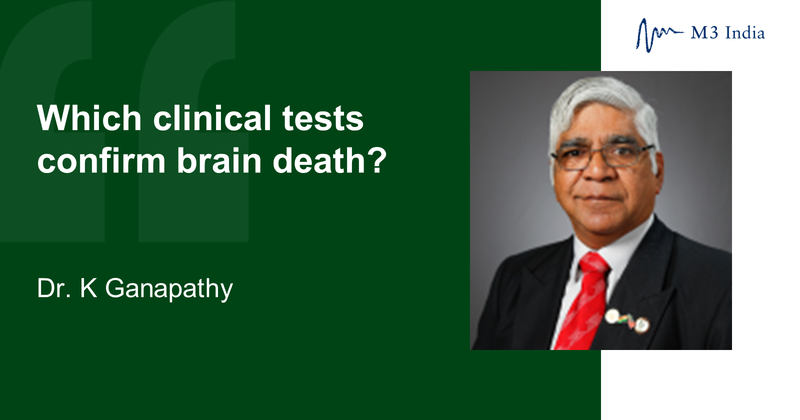Which clinical tests confirm brain death: Dr. K Ganapathy
M3 India Newsdesk Sep 24, 2018
Dr. Ganapathy Krishnan, an eminent Neurosurgeon provides details on the clinical tests required to be conducted for certifying brain death.

Diagnosis of brain death is mostly clinical and a patient should be certified brain dead only if they do not respond to external stimuli, their breathing can only be supported through a ventilator, and if they have incurred serious and irreversible brain damage. Apart from these criteria, the following tests should be performed by the doctor to confirm brain death.
Apnoea test
Apnoea testing is carried out only when all prerequisites have been met and all other brain stem reflexes are absent. Prerequisites include a core temperature of >36.5 degree Celsius, a systolic blood pressure of >90mm Hg and presence of euvolaemia. Components of the apnoea test include:
- absence of spontaneous respiratory efforts during a period of disconnection (10 minutes) from the mechanical ventilator, with the arterial CO2 reaching a critical point (>60 mmHg)
- measuring arterial pO2, pCO2, and pH after 10 minutes and reconnecting the ventilator
If the respiratory movements are absent and the arterial pCO2 is >60 mmHg (or a 20 mmHg increase in the pCO2 over the baseline value), the apnoea test is positive, i.e that brain stem reflex is absent.
Pupillary response to light
- The response to bright light should be absent in both the eyes
- The pupil should be observed closely for one minute to allow time for a slow response to become evident
Both widely dilated as well as mid-positioned fixed pupils are seen in brain dead patients. The presence of widely dilated pupils is not a necessary criterion for brain death but fixed pupils with no response to light is a mandatory requirement for its diagnosis. The size may vary from 4 to 9 mm.
Corneal reflex
This should be absent on both sides.
Oculocephalic reflex (doll’s eye phenomenon)
This test must not be performed in patients with an unstable cervical spine. In the test, the head is turned from the starting position to a new steady position, and then briskly turned towards the opposite side. The eyes should move to the contralateral side denoting the integrity of the medial longitudinal fasciculus in the brain stem.
Oculovestibular reflex
Ocular movements should be absent after head-turning and caloric testing with ice water.
- Before testing, both the ears must be inspected to confirm that the tympanic membranes are intact and that the external auditory canal is not obstructed
- The patient’s head should be placed in the centre and lifted 30 degree from the supine position
- A soft catheter should be introduced into the external auditory canal and slow irrigation, with at least 5 ml of ice-cold water, should be performed while the eyes are held open by an assistant
- The eyes should be observed for one minute after irrigation is completed before repeating the test on the other side
An intact oculo-vestibular reflex causes tonic deviation of the eyes opposite to that of the irrigated ear. Any movement of one or both eyes, whether conjugate or not, excludes the diagnosis of brain death. In a brain-dead patient, the eyes remain fixed.
A combined ice-cold water caloric stimulation and head rotation testing has been suggested as the most profound stimulation for deeply unconscious patients.
Gag reflex
This should be absent. A tongue depressor is used to stimulate each side of the oropharynx and the patient observed for any pharyngeal or palatal movement. Evaluation of the gag reflex may be difficult in an intubated patient and should not be performed if extubation is required for this test.
Cough reflex
A suction catheter is introduced into the endotracheal or tracheostomy tube to deliberately stimulate the carina. The patient is closely observed for any cough response or movement of the chest or diaphragm.
Pitfalls in clinical evaluation
The following conditions may interfere with the clinical diagnosis of brain death:
- severe facial trauma
- pre-existing pupillary abnormalities
- toxic levels of sedative drugs
- aminoglycosides
- tricyclic antidepressants
- anticholinergics
- antiepileptics
- chemotherapeutic agents
- neuromuscular blocking agents
- sleep apnoea
- severe pulmonary disease resulting in chronic retention of CO2
Other clinical observations that may be compatible with the diagnosis of brain death, but a source of confusion are motor responses ("Lazarus sign"). These may occur spontaneously during apnoea testing, often during the hypoxic or hypotensive episodes, and are of spinal origin. They include spontaneous movements of limbs other than pathologic flexion or extension response and respiratory-like movements (shoulder elevation and adduction, back arching, intercostal expansion without significant tidal volumes) and should not be misinterpreted as evidence of brain stem function.
Disclaimer- The views and opinions expressed in this article are those of the author's and do not necessarily reflect the official policy or position of M3 India.
The writer, Dr. Ganapathy Krishnan is a Emeritus Professor of Neurosurgery and the Past President of Neurological Society of India and Indian Society for Stereotactic & Functional Neurosurgery.
-
Exclusive Write-ups & Webinars by KOLs
-
Daily Quiz by specialty
-
Paid Market Research Surveys
-
Case discussions, News & Journals' summaries